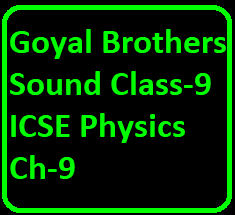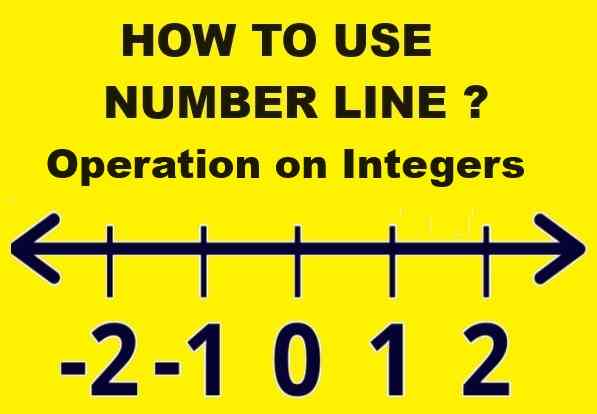Goyal Brothers Sound Class-9 ICSE Physics Ch-9. We Provide Step by Step Answer of Exercise, Subjective Sound Class-9, Visit official Website CISCE for detail information about ICSE Board Class-9 Physics.
Goyal Brothers Sound Class-9 ICSE Physics Ch-9
-: Select Topic :-
Exercise Objective Questions
Goyal Brothers Sound Class-9 ICSE Physics Ch-9
Multiple Choice Questions.
Select the correct option :
1. In case of longitudinal waves, the particles of the medium vibrate :
(a) in the direction of wave propagation
(b) opposite to the direction of wave propagation
(c) at right angles to the direction of wave propagation
(c) none of the above
Ans. (a) in the direction of wave propagation
2. A longitudinal wave consists of :
(a) crest and trough in the medium
(b) compression and rarefaction in the medium
(c) both (a) and (b)
(d) neither (a) nor (b)
Ans. (b) compression and rarefaction in the medium
3. The longitudinal waves can propagate only in .
(a) solids
(b) liquids
(c) gases
(d) all of these
Ans. (d) all of these
4. A part of the longitudinal wave in which particles of the medium are closer than the normal particles is called :
(a) rarefaction
(b) crest
(c) trough
(d) compression
Ans. (d) compression
5. A part of longitudinal wave in which particles of the medium are farther away than the normal particles is called :
(a) rarefaction
(b) trough
(c) compression
(d) crest
Ans. (a) rarefaction
6. In the region of compression or rarefaction, in a longitudinal wave, the physical quantity which does not change is :
(a) pressure
(b) mass
(c) density
(d) volume
Ans. (b) mass
7. The wavelength is the linear distance between the :
(a) two consecutive compressions
(b) two consecutive rarefactions
(c) one compression and one rarefaction
(d) both (a) and (b)
Ans. (d) both (a) and (b)
8. The number of oscillations passing through a point in unit time is called :
(a) vibration
(b) frequency
(c) wavelength
(d) amplitude
Ans. (b) frequency .
9. The SI unit of frequency is
(a) hertz
(b) gauss
(c) decibel
(d) none of these
Ans. (a) hertz
10. If the frequency of a wave is 25 Hz. the total number of compressions and rarefactions passing through a point in 1 second is :
(a) 25
(b) 50
(c) 100
(d) none of these
Ans. (b) 50
11. Which of the following is an elastic wave?
(a) light wave
(b) ratio wave
(c) sound wave
(d) microwave
Ans. (c) sound wave
Subjective Questions
Goyal Brothers Sound Class-9 ICSE Physics Ch-9
Question 1.
(a) What do you understand by the term sound energy?
(b) State three conditions necessary for hearing sound.
Answer:
(a) Sound energy : “It is a form of energy that produces the sensation of hearing in our ears.” Sound is produced when a body vibrates.
(b) Necessary conditions for hearing sound :
- There must be a vibrating body, capable of transferring its energy to its surroundings.
- These must be a material medium to pick the energy and then propagate it in forward direction.
- There must be a receiver, so as to receive the sound vibrations and then transmit them to the brain for final interpretation, such as human ear.
Question 2.
Describe briefly an experiment to prove that vibrating bodies produce sound.
Answer:
Experiment : Take a tuning fork. It is U-shaped fork made of steel provided with a handle.

Strike the tuning fork with a rubber hammer and hold it close to ear. A sound is heard. Now take a freely suspended pith ball and touch one end of the tuning fork (which is already hit with a rubber hammer) to it. It is observed that pith ball repeatedly flies outward. This experiment too proves that sound is produced by a vibrating body.
Question 3. (Goyal Brothers Sound Class-9 ICSE Physics)
(a) What do you understand by the term infrasonic vibrations?
(b) What do you understand by the term sonic vibrations? State the range of sonic vibrations for the human ear.
Answer:
(a) Infrasonic vibrations : Those vibrations whose frequency is less than 20 hertz are known as infrasonic vibrations
(b) Sonic vibrations : Sonic vibrations are also known as audio vibrations.
Those vibrations whose frequency is from 20 hertz to 20000 hertz are known as sonic vibrations.
The range of sonic vibrations is from 20 vibrations per second to 20000 vibrations per second.
Question 4.
(a) What do you understand by the term ultrasonic vibrations?
(b) Name three animals which can hear ultrasonic vibrations.
Answer:
(a) Ultrasonic vibrations : Those vibrations, whose frequency is more than 20000 hertz and are not perceived by human ear, are known as ultrasonic vibrations.
(b) Dogs, bats and dolphins can hear ultrasonic vibrations.
Question 5.
How do bats locate their prey during flight?
Answer:
Bats produce ultra sound which returns after striking an obstacle in their way. By hearing the reflected round, bats can judge the distance and direction of obstacle/prey in their way and hence bats can catch their prey during flight.
Question 6.
What is Galton’s whistle? To what use is it put?
Answer:
A special whistle which can produce ultra sound, not heard by humans, is called Galton’s whistle.
It is used to train dogs because they can hear ultrasounds upto a frequency of 40000 hertz.
Question 7.
State four practical uses of ultrasonic vibrations.
Answer:
Uses of ultrasonic vibrations :
- These are used for dissipating fogs on the runways at the airports.
- These are used in the ultrasound scanning of internal organs of human body.
- These are used for making dish washing machines. In these machines, water and detergents are vibrated with ultlrasonics vibrator. The vibrating particles of the dissolved detergent rub against the plates and clean them.
- These are used in SONAR (Sound navigation and ranging) to detect and find the distance of objects under water.
Question 8.
Describe an experiment to prove that material medium is necessary for the propagation of sound.
Answer:
A material medium is necessary for the propagation of sound. It can be proved with the help of following experiment :
An electric circuit consisting of a cell, a switch and an electric bell is arranged inside a bell-jar, which stands on the platform of an evacuating pump.
The switch of the bell is pressed to close the electric circuit. Sound is heard when there is air within the bell-jar. Air is now gradually pumped out of the bell-jar. The intensity of sound goes on decreasing, and no sound is heard when the air is completely removed from the bell-jar. It is because, the air which acts as a medium for the propagation of sound energy is removed.

From above experiment, it is clear that sound can not be heard in the absence of air i.e. a material medium is necessary for the propagation of sound.
Question 9.
Why do astronauts talk to each other through radio telephone in space?
Answer:
Sound can not travel through vacuum. There is no material medium in the space for propagation of sound. Hence astronauts talk to each other through radio telephone in space. In radio telephone, message of one astronauts reach to the other with the help of radio waves, which can travel through vacuum.
Question 10. (Goyal Brothers Sound Class-9 ICSE Physics)
Define the terms :
- wavelength
- amplitude
- frequency.
Answer:
(i) Wavlength : The linear distance between the two consecutive particles of a vibrating medium in the same phase is called its wavelength. It is denoted by Greek letter lambda (λ).
OR
The distance travelled by the wave in one time period of vibration of the particles of medium is called its wavelength.
OR
In a longitudinal wave, distance between the two consecutive compressions or rare fractions is called wavelength.
(ii) Amplitude : The maximum displacement of a vibrating particles about its mean position is called amplitude.
(iii) Frequency : It is denoted by letter (ƒ). The number of complete vibrations executed by a vibrating particle of a medium about its mean position in one second is called its frequency.
OR
It may be defined as the number of waves passing through one particular point in one second.
Question 11.
State four differences between the sound wave and the light wave.
Answer:
Differences between the sound wave and light wave :
Light waves :
- They are produced from the electrons in an excited state.
- They travel at a very high speed of 3 x 108 ms-1 in air.
- They can travel through vacuum.
- Their velocity does not change with the change in temperature, humidity, etc.
- They can produce the sensation of vision.
Sound waves :
- They are produced due to vibrations of various objects in a material medium.
- They travel in air at a very low speed of 332 ms-1 at 20°C.
- They cannot travel through vacuum and always require some material medium for propagation.
- Their velocity changes with the change in velocity, humidity, etc.
- They can produce the sensation of hearing.
Question 12.
What is meant by the term wave motion?
Answer:
Wave motion : The transference of energy when the particles of a medium, move about their mean position is called wave motion.
Question 13.
State the relation between the wavelength and the frequency.
Answer:
Consider a wave is propagating through a medium,
Let,ƒ = Frequency of wave
λ = Wavelength of wave
T = Time period of the wave.
In the time ‘T’, distance covered by wave = λ
In the time 1 second, distance covered by wave = λ/T
But distance covered by wave in one second = v = Velocity of the wave

Which is the required relation between wavelength and frequency.
Question 14. (Goyal Brothers Sound Class-9 ICSE Physics)
What kinds of the waves are produced in solids, liquids and gases?
Answer:
Elastic waves or material waves are produced in solids, liquids and gases.
Question 15.
The sound of an explosion on the surface of lake is heard by a boatman 100 m away and a diver 100 m below the point of explosion.
- Of the two persons mentioned (boatman and diver), who would hear the sound first?
- Give reason for your answer in (i).
- If the sound takes ‘t’ seconds to reach the boatman, approximately how mcuh time it will take to reach the diver?
Answer:
- Diver would hear the sound first.
- Because velocity of sound in water (1450 ms-1) is more than the velocity of sound in air (332 ms-1).
- Time taken by sound to reach the diver would be less than t, where t is the time taken by sound to reach the boatman.
Note : Time taken by sound to reach the diver would be 4.36 times less than the time taken by sound to reach the boatman.
Question 16.
What is approximate value of speed of sound in iron as compared to that in air? Illustrate your answer with a simple experiment.
Answer:
Speed of sound in iron is approximately sixteen times the speed of sound in air.
[Speed of sound in iron = 5100 ms-1; Speed of sound in air=332 ms-1]
Experiment : If we put our ears to rails, we can hear the sound of the train through metal. But at the same time, when we stand near by the railway track, we are not able to hear the sound.
This occurs because when we put our ears to rails, the sound travels through iron. But in standing position, sound travels through air and due to smaller speed of sound in air as compared to iron, we are not able to hear the sound.
Question 17.
How does a bat avoid obstacles in its way when in flight?
Answer:
Bats make a series of twittering sound, so high pitched that human ear can not hear. These sound waves strike against the obstacles less in their path of flight and send back echoes to the bat’s ear. The echoes tell the bats, how they must turn in the air to avoid colliding with the obstacles or with one another.
Question 18.
A continuous disturbance is created on the surface of water in a ripple tank with a small piece of cork floating on it. Describe the motion of the cork. What does the motion of the cork tell about the disturbance?
Answer:
Cork will move up and down about the mean position at the same position along horizontal.
It tells as that only the disturbance/energy is transferred from one particle to the other but particles of the medium do not move from one position to the other.
Question 19.
Draw a displacement-time graph for water wave.
Answer:
Displacement-time graph for water wave :

Practice Problems
Goyal Brothers Sound Class-9 ICSE Physics Ch-9
Practice Problems 1
Question 1. (Goyal Brothers Sound Class-9 ICSE Physics)
200 waves pass through a point in one second. Calculate the time period of wave.
Answer:
Waves passing through a point in 1 second = 200
We know, frequency (ƒ) = Number of waves passing through point in 1 second.
∴ ƒ = 200Hz

Question 2.
A bat emits an ultrasonic sound of frequency 0.25 MHz. Calculate the time in which one vibration is completed.
Answer:
Frequency of ultrasound = ƒ = 0.25 MHz
ƒ = 0.25 × 106 Hz

Practice Problems 2
Question 1.
The sonic boom of an aircraft has a time period of 0.00005s. Calculate the frequency of sound produced.
Answer:

Question 2.
An electromagnetic wave has a time period of 4 × 10-8 s. Calculate its frequency in MHz.
Answer:
Time period = T = 4 × 10-8 s
Frequency of sound = ƒ = ?

Practice Problems 3
Question 1.
An ultraviolet radiation has a wavelength of 300Å. If the velocity of electromagnetic wave is 3 × 108 ms-1. Calculate
- frequency
- time period.
Answer:

Question 2.
The wavelength of the vibrations produced on the surface of water is 2 cm. If the wave velocity is 16 ms-1, calculate
- no. of waves produced in one second
- time required to produce one wave.
Answer:

Practice Problems 4
Question 1.
A continuous progressive transverse wave of frequency 8 Hz moves across the surface of a ripple tank
(a) With reference to the frequency, describe the movement of water on the surface
(b) If the wavelength of transverse wave is 32 mm, calculate the speed with which wave travels across the surface of water.
Answer:

Question 2. (Goyal Brothers Sound Class-9 ICSE Physics)
A thin metal plate is placed against the teeth of cog wheel. Cog wheel is rotated at a speed of 120 rotations per minute and has 160 teeth. Calculate :
- frequency of node produced.
- speed of sound, if wavelength is 1.05 m.
- what will be the effect when speed of cog wheel is doubled?
Answer:
Frequency for rotation of wheel = 120 rotations per minute

Practice Problems 5
Question 1.
A sound wave of wavelength 1/3 m has a frequency 996 Hz. Keeping the medium same, if frequency changes to 1328 Hz. Calculate
- velcoity of sound
- new wavelength.
Answer:


Question 2.
Two tuning forks A and B of frequencies 256 Hz and 192 Hz respectively are vibrated in air. If the wavelength of A is 1.25 m, calculate the wavelength produced by B.
Answer:

Practice Problems 6
Question 1. (Goyal Brothers Sound Class-9 ICSE Physics)
The distance between one crest and one trough of a sea wave is 4.5 m. If the waves are produced at the rate of 240/min, calculate
- time period
- wave velocity.
Answer:
Distance between one crest and one trough of a sea wave = 4.5 m


Question 2.
The distance between three consecutive crests of wave is 60 cm. If the waves are produced at the rate of 180/ min, calculate
- wavelength
- time period
- wave velocity.
Answer:

Practice Problems 7
Question 1.
The diagram given below shows a displacement distance graph of a wave. If the velocity of wave is 160 ms-1, calculate
- wavelength
- frequency
- amplitude.

Answer:

Question 2. (Goyal Brothers Sound Class-9 ICSE Physics)
From diagram given below calculate
- velocity of P and Q
- frequency of P, when frequency of Q is 512 Hz.
Assume that both wave are travelling in same medium.

Answer:


-: End of Goyal Brothers : Sound Class-9 ICSE Physics Ch-9:-
Return to — Goyal Brothers ICSE Physics Class-9
Thanks




